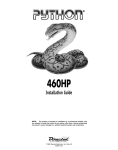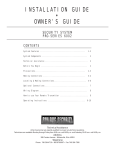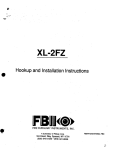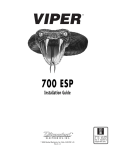Download DEI 7000ESP Installation guide
Transcript
7000 ESP Installation Guide ® © 2001 Directed Electronics, Inc. Vista, CA N381 5-01 Rev. M 1.0 table of contents Primary Harness (H1), 12-Pin Connector . . . . . 3 Primary Harness Wiring Diagram . . . . . . . . . 3 Primary Harness Wiring Guide . . . . . . . . . . . 3 Shock Sensor, 4-Pin Plug . . . . . . . . . . . . . 22 Programmer Interface, 3-Pin Plug . . . . . . . . 22 Voice Module Interface, 3-Pin Plug . . . . . . . 22 Relay Harness (H2), 8-Pin Connector . . . . . . . 8 Relay Harness Wiring Diagram . . . . . . . . . . . 8 Relay Harness Wiring Guide. . . . . . . . . . . . . 8 Internal Programming Jumper . . . . . . . . . . . 23 Light Flash Jumper . . . . . . . . . . . . . . . . . 23 Wiring the Door Lock System . . . . . . . . . . . . . 9 Identifying the Door Lock System . . . . . . . . 9 At the Switch. . . . . . . . . . . . . . . . . . . . . 10 Type A: Positive-Triggered, Relay Driven Systems . . . . . . . . . . . . . . . . . . . . . . . . 10 Type B: Negative-Triggered, Relay Driven Systems . . . . . . . . . . . . . . . . . . . . . . . . 11 Type C: Testing Reverse Polarity Systems Reversing Polarity . . . . . . . . . . . . . . . . . 11 Type D: Adding one or More Aftermarket Actuators . . . . . . . . . . . . . . . . . . . . . . . 13 Type E: Electrically Activated Vacuum . . . . . 14 Type F: One-Wire System, Cut to Lock, Ground To Unlock . . . . . . . . . . . . . . . . . . 15 Type G: Positive (+) Multiplex . . . . . . . . . . 15 Type H: Negative (-) Multiplex . . . . . . . . . . 16 System Features Menus . . . . . . . . . . . . . . . . Feature Menu 1: Basic Features. . . . . . . . . Feature Menu 2: Advanced Features . . . . . . Feature Menu 3: Auxiliary Channel Outputs. . 26 26 26 27 Feature Descriptions . . . . . . . . . . . . . . . . . Feature Menu 1: Basic Features. . . . . . . . . Feature Menu 2: Advanced Features . . . . . . Feature Menu 3: Auxiliary Channel Outputs. . 27 27 29 30 Auxiliary Output Harness (H3), 11-Pin Connector . . . . . . . . . . . . . . . . . . Auxiliary Output Harness Wiring Diagram . Auxiliary Output Harness Wiring Guide. . . Driver’s Door Priority Unlock Diagrams. . . System Features Learn Routine . . . . . . . . . . 24 Transmitter/Receiver Learn Routine . . . . . . . 32 Transmitter Configurations . . . . . . . . . . . . . . 34 Standard Configuration. . . . . . . . . . . . . . . 34 Expanded Configuration . . . . . . . . . . . . . . 34 Multi-Level Security Arming . . . . . . . . . . . . . 35 Transmitter Code Linking . . . . . . . . . . . . . . . 35 Table of Zones. . . . . . . . . . . . . . . . . . . . . . 36 . . . . . . . . 18 18 18 20 Plug-In Harnesses . . . . . . . . . . . . . . . . . . . . 21 Super Bright LED, 2-Pin Plug . . . . . . . . . . . 21 Valet/Program Switch, 2-Pin Plug. . . . . . . . 21 Long-Term Event History . . . . . . . . . . . . . . . 37 Optional Vehicle Recovery System . . . . . . . . 37 Rapid Resume Logic . . . . . . . . . . . . . . . . . . 38 Troubleshooting. . . . . . . . . . . . . . . . . . . . . 39 Wiring Quick Reference Guide . . . . . . . . . . . 40 The Bitwriter® (p/n 998T) requires chip version 1.4 or newer to program this unit. 2 © 2001 Directed Electronics, Inc. Vista, CA primary harness (H1), 12-pin connector primary harness wiring diagram H1/1 H1/2 H1/3 H1/4 H1/5 H1/6 H1/7 H1/8 ___ ___ ___ ___ ___ ___ ___ ___ ORANGE WHITE (-) 500 mA GROUND-WHEN-ARMED OUTPUT (+/-) SELECTABLE LIGHT FLASH OUTPUT WHITE/BLUE (-) 200 mA CHANNEL 3 PROGRAMMABLE OUTPUT BLACK/WHITE OUTPUT OF DOMELIGHT SUPERVISION RELAY #30 GREEN BLUE (-) DOOR TRIGGER INPUT, ZONE 3 (-) INSTANT TRIGGER INPUT, ZONE 1 VIOLET (+) DOOR TRIGGER INPUT, ZONE 3 BLACK (-) CHASSIS GROUND INPUT H1/9 ___ YELLOW (+) SWITCHED IGNITION INPUT, ZONE 8 H1/10 ___ BROWN (+) SIREN OUTPUT H1/11 ___ RED H1/12 ___ RED/WHITE (+) 12V CONSTANT POWER INPUT OUTPUT OF CHANNEL 2 RELAY #30 primary harness wiring guide This guide describes in detail the connection of each wire. Also included are possible applications of each wire. This system was designed with the ultimate in flexibility and security in mind. Many of the wires have more than one possible function. Please read the instructions carefully to ensure a thorough understanding of this system and how it operates. H1/1 ORANGE (-) GROUND-WHEN-ARMED OUTPUT This wire supplies a (-) ground as long as the system is armed. This output ceases as soon as the system is disarmed. The orange wire is pre-wired to control the P/N 8618 starter kill relay. It can supply up to 500 mA of current. NOTE: If connecting the orange wire to control another module, such as a P/N 529T or P/N 530T window module, a 1 amp diode (type 1N4004) will be required. (See the following diagram.) © 2001 Directed Electronics, Inc. Vista, CA 3 IMPORTANT! Never interrupt any wire other than the starter wire. H1/2 WHITE (+/-) SELECTABLE LIGHT FLASH OUTPUT As shipped, this wire should be connected to the (+) parking light wire. If the light flash polarity jumper under the sliding door is moved to the opposite position (see Internal Programming Jumpers section of this guide), this wire supplies a (-) 200 mA output. This is suitable for driving (-) light control wires in vehicles such as Toyota, Lexus, BMW, some Mitsubishi, some Mazda, and other model cars. (+) LIGHT FLASH OUTPUT (-) LIGHT FLASH OUTPUT H1/3 WHITE/BLUE (-) 200 mA CHANNEL 3 PROGRAMMABLE OUTPUT This wire provides a 200 mA (-) output whenever the transmitter button(s) controlling Channel 3 is pressed. This output can be programmed to provide the following types of output (also see System Features Learn Routine section of this guide): 4 © 2001 Directed Electronics, Inc. Vista, CA ■ A validity output will send a signal as long as the transmission is received. ■ A latched output will send a signal continuously when Channel 3 is pressed and will continue until Channel 3 is pressed again. ■ A latched/reset with ignition output functions similarly to the latched output, but will also reset (output will stop) when the ignition is turned on and then off. ■ A 30-second timed output will send a signal for 30 seconds when Channel 3 is pressed. This output can be shut off during the 30-second period by pressing the Channel 3 transmitter button(s) again. IMPORTANT! Never use this wire to drive anything but a relay or a low-current input! This transistorized output can only supply 200 mA, and connecting directly to a solenoid, motor, or other high-current device will cause the module to fail. H1/4 BLACK/WHITE HIGH CURRENT OUTPUT FROM ON-BOARD DOMELIGHT SUPERVISION RELAY Connect this wire directly to the domelight circuit in the vehicle. The on-board relay will drive circuits up to 20 amperes. The polarity of this output is determined by the connection of the input wire (H2/B) in the Door Lock Harness. NOTE: If the input wire (H2/B) is not connected, there will be no output on this wire. H1/5 GREEN (-) DOOR TRIGGER INPUT, ZONE 3 Most vehicles use negative door trigger circuits. Connect the green wire to a wire showing ground when any door is opened. In vehicles with factory delays on the domelight circuit, there is usually a wire unaffected by the delay circuitry. This wire will report Zone 3. H1/6 BLUE (-) INSTANT TRIGGER, ZONE 1 This input will respond to a negative input with an instant trigger. It is ideal for hood and trunk pins and will report on Zone 1. It can also be used with 506T Glass Breakage Sensor, as well as other DEI single stage sensors. The H1/6 BLUE instant trigger wire can be used to shunt sensors during operation, using the auxiliary channels. When any of the auxiliary channels are transmitted, the H1/6 BLUE wire monitors for a ground. If a ground is detected within 5 seconds of transmission, the sensors and the instant trigger input on the BLUE wire will be shunted until 5 seconds after the ground is removed. This allows the customer to access the trunk, remote start the vehicle or roll the windows down without first disarming the alarm. (See Bypassing Sensor Inputs section of this guide.) © 2001 Directed Electronics, Inc. Vista, CA 5 H1/7 VIOLET (+) DOOR TRIGGER INPUT, ZONE 3 This type of domelight circuit is used in many Ford vehicles. Connect the violet wire to a wire that shows (+)12V when any door is opened, and ground when the door is closed. This wire will report Zone 3. H1/8 BLACK (-) CHASSIS GROUND INPUT Remove any paint and connect this wire to bare metal, preferably with a factory bolt rather than your own screw. (Screws tend to either strip or loosen with time.) We recommend grounding all your components, including the siren, to the same point in the vehicle. H1/9 YELLOW (+) SWITCHED IGNITION INPUT, ZONE 8 Connect this wire to the (+)12V ignition wire. This wire is pre-wired to the starter kill relay and must show (+)12V with the key in the run position and during cranking. Take great care that this wire cannot be shorted to the chassis at any point. This wire will report Zone 8. 6 © 2001 Directed Electronics, Inc. Vista, CA H1/10 BROWN (+) SIREN OUTPUT Connect this to the red wire of the Revenger siren. Connect the black wire of the siren to (-) chassis ground, preferably at the same point you connect the control module’s black ground wire. H1/11 RED (+)12V CONSTANT POWER INPUT Before connecting this wire, remove the supplied fuse. Connect to the positive battery terminal or to the constant 12V supply to the ignition switch. NOTE: Always use a fuse within 12 inches of the point you obtain (+)12V. Do not use the 15 amp fuse in the harness for this purpose. This fuse protects the module itself. H1/12 RED/WHITE HIGH CURRENT OUTPUT FROM ON-BOARD CHANNEL 2 RELAY Whenever the button(s) controlling Channel 2 is pressed for 1.5 seconds, the on-board relay is activated and will stay active as long as the transmission continues. This relay is often used for trunk release. The relay can drive circuits up to 20 amperes. The polarity of this output is determined by the connection of the input wire (H2/A) on the Door Lock Harness. NOTE: If the input wire (H2/A) is not connected, there will be no output from the relay when it is activated. © 2001 Directed Electronics, Inc. Vista, CA 7 relay harness (H2), 8-pin connector relay harness wiring diagram H2/A H2/B H2/C H2/D H2/E H2/F H2/G H2/H ___ ___ ___ ___ ___ ___ ___ ___ RED/WHITE BLACK/WHITE CHANNEL 2 RELAY INPUT #87 DOMELIGHT SUPERVISION RELAY INPUT #87 WHITE/BLACK LOCK #87A NORMALLY CLOSED GREEN/BLACK LOCK #30 COMMON (OUTPUT) VIOLET/BLACK* LOCK #87 NORMALLY OPEN (INPUT) BROWN/BLACK UNLOCK #87A NORMALLY CLOSED BLUE/BLACK VIOLET* UNLOCK #30 COMMON (OUTPUT) UNLOCK #87 NORMALLY OPEN (INPUT) *NOTE: VIOLET and VIOLET/BLACK are common at fuse holder. relay harness wiring guide H2/A RED/WHITE INPUT TO ON-BOARD CHANNEL 2 (TRUNK RELEASE) RELAY This wire is used to supply voltage to the H1/12 output. If you want a positive output on the H1/12 wire, connect this wire to (+)12V. Always fuse appropriately. If a negative output is desired, connect the H2/A red/white wire to chassis ground. H2/B BLACK/WHITE INPUT TO DOMELIGHT SUPERVISION RELAY This wire determines what the output polarity of the H1/4 wire will be. If the door pin circuit is negative, connect to chassis ground. If the doorpin circuit is positive, connect to a fused 12V source. H2/C, H2/D, H2/E, H2/F, H2/G, AND H2/H POWER DOOR LOCK WIRES This security system has door lock relays on-board the control module, and can directly interface with most electric power door lock systems drawing 30 amps or less. It can also drive aftermarket actuators directly. Some vehicles require that an aftermarket actuator be added to the driver’s door to allow system control. (See Type D wiring.) 8 © 2001 Directed Electronics, Inc. Vista, CA wiring the door lock system identifying the door lock system The easiest way to determine which type of door lock system you are working with is to remove the master locking switch itself, which is usually on the driver’s door or on the center console. Once you have determined which type of factory door lock circuit you are working with, and the color codes of the switch wires to be used, you can usually simplify the installation by locating the same wires in the vehicle’s kick panel. If no central locking switch is found, the installation may require a door lock actuator. NOTE: Always retest the wires in the kick panel to be sure they work the same as the wires on the switch. There are eight common types of door lock circuits: TYPE A: 3-WIRE (+) PULSE CONTROLLING FACTORY LOCK RELAYS Most GM, some Ford and Chrysler, 1995 and newer Saturns, some new VW, newer BMW. TYPE B: 3-WIRE (-) PULSE CONTROLLING FACTORY LOCK RELAYS Most Asian vehicles, early Saturn, some BMW and Porsche. TYPE C: DIRECTLY-WIRED REVERSING-POLARITY SWITCHES The switches are wired directly to the motors. This type of system has no factory relays. Most Fords, many GM two-doors cars and trucks, many Chryslers. TYPE D: ADDING ONE OR MORE AFTER-MARKET ACTUATORS These include slave systems without an actuator in the driver’s door, but with factory actuators in all the other doors. Type D also includes vehicles without power locks, which are having actuators added. All Saabs before 1994, most Volvo (except 850i), most Subaru, most Isuzu, and many Mazdas. Some mid-eighties Nissans, pre-1985 Mercedes-Benz and Audi. TYPE E: ELECTRICALLY ACTIVATED VACUUM SYSTEMS The vehicle must have a vacuum actuator in each door. Make sure that locking the doors from the driver's or passenger side using the key activates all the actuators in the vehicle. This requires a slight modification to the door lock harness. Mercedes-Benz and Audi 1985 and newer. TYPE F: ONE-WIRE SYSTEM - CUT TO LOCK, GROUND TO UNLOCK This system is found in the late-model Nissan Sentra, some Nissan 240SX, and Nissan 300ZX 1992 and later. It is also found in older Mitsubishis, and some early Mazda MPV’s. © 2001 Directed Electronics, Inc. Vista, CA 9 TYPE G: (+) MULTIPLEX SYSTEM This system is most commonly found in Ford, Mazda, Chrysler and GM vehicles. The door lock switch or door key cylinder may contain either one or two resistors. TYPE H: (-) MULTIPLEX SYSTEM The system is most commonly found in Ford, Mazda, Chrysler and GM vehicles. The door lock switch or door key cylinder may contain either one or two resistors. at the switch ■ Three-wire switches will have either a constant ground input or a constant (+)12V input, along with the pulsed lock and unlock outputs to the factory relays. ■ Many BMW’s and VW’s have no external switch. The switches are inside the actuator, and instead of pulsing, the proper wires will switch back and forth from (+)12V to (-) ground as the door locks are operated. ■ Direct-wired switches will have a (+) 12V constant input and one or two (-) ground inputs, along with two output leads going directly to the lock motors. type A: positive-triggered, relay-driven systems IMPORTANT! The H2/A and H2/B wires are not required for wiring the door locks. For detailed wiring instructions for these two wires, refer to the beginning of the Door Lock Harness (H2) Wire Connection Guide section. Depending on the type of door lock system, there may be additional H2 harness wires that are not used for wiring the door locks. 10 © 2001 Directed Electronics, Inc. Vista, CA type B: negative-triggered, relay-driven systems IMPORTANT! The H2/A and H2/B wires are not required for wiring the door locks. For detailed wiring instructions for these two wires, refer to the beginning of the Door Lock Harness (H2) Wire Connection Guide section. Depending on the type of door lock system, there may be additional H2 harness wires that are not used for wiring the door locks. type C: reverse polarity systems Use these instructions if the power door lock switch has four or five heavy-gauge wires. This type of switch has two outputs that rest at (-) ground. IMPORTANT! To interface with Type C systems, you must cut two switch leads. The relays must duplicate the factory door lock switches’ operation. The master switch will have one or two ground inputs, one (+)12V input, and two switch outputs going directly to the slave switch and through to the motors. These outputs rest at (-) ground. The lock or unlock wire is switched to (+)12V, while the other wire is still grounded, thus completing the circuit and powering the motor. This will disconnect the switch from the motor before supplying the motor with (+)12V, avoiding sending (+)12V directly to (-) ground. It is critical to identify the proper wires and locate the master switch to interface properly. Locate wires that show voltage when the switch is moved to the lock or unlock position. Cut one of these wires and check operation of the locks from both switches. If one switch loses all operation in both directions then you have cut one of the correct wires and the switch that is entirely dead is the master switch. If both switches still operate in any way and one or more door motors have stopped responding entirely, you have cut a motor lead. Reconnect © 2001 Directed Electronics, Inc. Vista, CA 11 it and continue to test for another wire. Once both wires have been located and the master switch has been identified, cut both wires and interface as shown in the following diagram. WARNING! If these wires are not connected properly, you will send (+)12 volts directly to (-) ground, possibly damaging the control module or the factory switch. IMPORTANT! The H2/A and H2/B wires are not required for wiring the door locks. For detailed wiring instructions for these two wires, refer to the beginning of the Door Lock Harness (H2) Wire Connection Guide section. Depending on the type of door lock system, there may be additional H2 harness wires that are not used for wiring the door locks. H2/C WHITE/BLACK Once both door lock wires are located and cut, connect the white/black wire to the master switch side of the lock wire. The master switch side will show (+)12V when the master switch is operated to the lock position and (-) ground when the master switch is in the middle position. H2/D GREEN/BLACK Connect the green/black wire to the other side of the lock wire. This is the motor side of the lock wire and it goes to the lock motor through the slave switch. H2/E VIOLET/BLACK This wire must be connected to a constant (+)12V source. The best connection point for this wire is the constant (+)12 volt supply for the door lock switch*, or directly to the (+) battery post with a fuse at the battery post. 12 © 2001 Directed Electronics, Inc. Vista, CA *NOTE: Except in GM cars with retained accessory power (RAP). In these vehicles, the (+)12V feed to the door lock switches is turned off if the doors are closed for any length of time. NOTE: Most direct-wired power lock systems require 20-30 amps of current to operate. Connecting the violet/black wire to a poor source of voltage will prevent the door locks from operating properly. H2/F BROWN/BLACK Connect the brown/black wire to the master switch side of the unlock wire. The master switch side will show (+)12V when the master switch is in the unlock position and (-) ground when the master switch is in the middle position. H2/G BLUE/BLACK Connect the blue/black wire to the other side of the unlock wire. type D: adding one or more after-market actuators Vehicles without factory power door locks require the installation of one actuator per door. This requires mounting the door lock actuator inside the door. Other vehicles may only require one actuator to be installed in the driver's door if all door locks are operated when the driver's lock is used. IMPORTANT! The H2/A and H2/B wires are not required for wiring the door locks. For detailed wiring instructions for these two wires, refer to the beginning of the Door Lock Harness (H2) Wire Connection Guide section. Depending on the type of door lock system, there may be additional H2 harness wires that are not used for wiring the door locks. © 2001 Directed Electronics, Inc. Vista, CA 13 type E: electrically-activated vacuum This system is found in Mercedes-Benz and Audi 1985 and newer. The door locks are controlled by an electrically activated vacuum pump. The control wire will show (+) 12V when doors are unlocked and (-) ground when doors are locked. NOTE: The system must be programmed for 3.5 sec door lock pulses. IMPORTANT! The H2/A and H2/B wires are not required for wiring the door locks. For detailed wiring instructions for these two wires, refer to the beginning of the Door Lock Harness (H2) Wire Connection Guide section. Depending on the type of door lock system, there may be additional H2 harness wires that are not used for wiring the door locks. 14 © 2001 Directed Electronics, Inc. Vista, CA type F: one-wire system - cut to lock, ground to unlock This system usually requires a negative pulse to unlock, and cutting the wire to lock the door. (In some vehicles, these wires are reversed.) Type F door locks are used in the late-model Nissan Sentra, some Nissan 240SX, and Nissan 300ZX 1992 and later. They are also used in some Mazda MPV's. NOTE: The violet jumper between the #87 lock terminal and the #87 unlock terminal must be cut. IMPORTANT! The H2/A and H2/B wires are not required for wiring the door locks. For detailed wiring instructions for these two wires, refer to the beginning of the Door Lock Harness (H2) Wire Connection Guide section. Depending on the type of door lock system, there may be additional H2 harness wires that are not used for wiring the door locks. type G: positive (+) multiplex This system is most commonly found in Ford, Mazda, Chrysler and GM vehicles. The door lock switch or door key cylinder may contain either one or two resistors. SINGLE-RESISTOR TYPE: If one resistor is used in the door lock switch/key cylinder, the wire will pulse (+)12V in one direction and less than (+)12V when operated in the opposite direction. TWO-RESISTOR TYPE: If two resistors are used in the factory door lock switch/key cylinder, the switch/key cylinder will read less than (+)12V in both directions. © 2001 Directed Electronics, Inc. Vista, CA 15 DETERMINING THE PROPER RESISTOR VALUES: To determine the resistor values, the door lock switch/key cylinder must be isolated from the factory door lock system. For testing, use a calibrated digital multimeter that is set to ohms. IMPORTANT! To ensure an accurate resistance reading, do not touch the resistor or leads during testing. 1. Cut the output wire from the door lock switch/key cylinder in half. 2. Test with the meter from the switch side of the cut door lock switch/key cylinder wire to a reliable constant (+)12V source. Some good constant (+)12V references are the power input source to the door lock switch/key cylinder, the ignition switch power wire, or the (+) terminal of the battery. 3. Operate the door lock switch/key cylinder in both directions to determine the resistor values. If the multimeter displays zero resistance in one direction, no resistor is needed for that direction. 4. Once the resistor value(s) is determined, refer to the wiring diagram for proper wiring. IMPORTANT! The H2/A and H2/B wires are not required for wiring the door locks. For detailed wiring instructions for these two wires, refer to the beginning of the Door Lock Harness (H2) Wire Connection Guide section. Depending on the type of door lock system, there may be additional H2 harness wires that are not used for wiring the door locks. type H: negative (-) multiplex The system is most commonly found in Ford, Mazda, Chrysler and GM vehicles. The door lock switch or door key cylinder may contain either one or two resistors. 16 © 2001 Directed Electronics, Inc. Vista, CA SINGLE-RESISTOR TYPE: If one resistor is used in the door lock switch/key cylinder, the wire will pulse ground in one direction and resistance to ground when operated in the opposite direction. TWO-RESISTOR TYPE: If two resistors are used in the factory door lock switch/key cylinder, the door lock switch/key cylinder will read resistance to ground in both directions. DETERMINING THE PROPER RESISTOR VALUES: To determine the resistor values, the door lock switch/key cylinder must be isolated from the factory door lock system. For testing, use a calibrated digital multimeter that is set to ohms. IMPORTANT! To ensure an accurate resistance reading, do not touch the resistor or leads during testing. 1. Cut the output wire from the door lock switch/key cylinder in half. 2. Test with the meter from the switch side of the cut door lock switch/key cylinder wire to a reliable ground source. Some good ground references are the ground input source to the door lock switch/key cylinder or the battery ground. 3. Operate the door lock switch/key cylinder in both directions to determine the resistor values. If the multimeter displays zero resistance in one direction, no resistor is needed for that direction. 4. Once the resistor value(s) is determined, refer to the wiring diagram for proper wiring. IMPORTANT! The H2/A and H2/B wires are not required for wiring the door locks. For detailed wiring instructions for these two wires, refer to the beginning of the Door Lock Harness (H2) Wire Connection Guide section. Depending on the type of door lock system, there may be additional H2 harness wires that are not used for wiring the door locks. © 2001 Directed Electronics, Inc. Vista, CA 17 auxiliary output harness (H3), 11-pin connector auxiliary output harness wiring diagram H3/1 H3/2 H3/3 H3/4 H3/5 H3/6 H3/7 H3/8 H3/9 ___ ___ ___ ___ ___ ___ ___ ___ ___ GREEN/BROWN (-) SENSOR INPUT MULTIPLEX ZONES 4 AND 6 BROWN/BLACK (-) SENSOR SHUNT INPUT PURPLE/BLACK (-) 200 mA CHANNEL 4 OUTPUT GRAY/BLACK (-) 200 mA CHANNEL 5 OUTPUT WHITE/BLACK (-) 200 mA CHANNEL 6 OUTPUT BROWN BLUE GREEN ORANGE/BLACK H3/10 ___ BLACK/WHITE H3/11 ___ PINK/BLACK (-) 200 mA HORN HONK OUTPUT (-) 200 mA SECOND UNLOCK/CHANNEL 7 (-) 200 mA FACTORY SECURITY DISARM OUTPUT (+) GHOST SWITCH INPUT IGNITION LOCK SAFETY INPUT (-) DELAYED ACCESSORY OUTPUT auxiliary output harness wiring guide H3/1 GREEN/BROWN (-) MULTIPLEX SENSOR INPUT This multiplexed input is capable of triggering either the Warn Away response or the triggered sequence. Inputs that are shorter than 0.8 seconds will only trigger Warn Away. The first stage of DEI dual stage sensors supplies this type of pulse. Inputs that are longer than 0.8 seconds will trigger the full alarm cycle. The full trigger will report on Zone 4 and the Warn Away will report on Zone 6. H3/2 BROWN/BLACK (-) SENSOR SHUNT INPUT When ground is applied to this wire, all sensors will be bypassed. The only inputs capable of triggering the system while this wire is grounded are the door trigger and the ignition. After ground is removed, the system will begin responding to sensors after 5 seconds. During the 5 second recovery period, an input from any sensor will reset the 5-second recovery timer. This wire can be used to bypass sensors for remote starting, window roll up, etc. PROGRAMMABLE OUTPUTS The outputs for Channels 4 (H3/3), 5 (H3/4) and 6 (H3/5) are programmable. Each of the outputs supplies 200 mA of current and cannot directly drive high current circuits. Selectability allows the installer to configure the system for a wide range of applications. The four types of outputs that are available are: 18 © 2001 Directed Electronics, Inc. Vista, CA ■ Validity: Output that lasts as long as the button is pressed. ■ Latched: Output that turns on the first time the button is pressed and turns off the next time the same button is pressed. ■ Latched, reset with ignition: Output that turns on the first time the button is pressed and turns off the next time the same button is pressed. This output will cease when the ignition is turned on then off. ■ Timed: Output that turns on for a selectable amount of time and stays on until the time runs out or the transmitter button is pressed again. H3/3 PURPLE/BLACK (-) CHANNEL 4 OUTPUT This output is programmable for a latched, latched/reset with ignition, validity (default), or timed output. The timed output is programmable for 30, 60, or 90 seconds. H3/4 GRAY/BLACK (-) CHANNEL 5 OUTPUT This output is programmable for a latched, latched/reset with ignition, validity (default), or timed output. The timed output is programmable for 30, 60, or 90 seconds. H3/5 WHITE/BLACK (-) CHANNEL 6 OUTPUT This output is programmable for a latched, latched/reset with ignition, validity (default), or timed output. The timed output is programmable for 5, 10, 20, 25, or 30 seconds. If using the DEI Bitwriter or the Techsoft Programmer this output can be programmed for 1-90 seconds. H3/6 BROWN (-) HORN HONK OUTPUT This wire provides a 200mA output to drive a low current factory horn circuit. The output can be programmed for a constant or pulsed output to honk the horn during the full trigger sequence. If the horn circuit is high current or positive, a relay will be required to drive the circuit. H3/7 BLUE (-) SECOND UNLOCK/CHANNEL SEVEN OUTPUT This wire will output a one second 200 mA negative pulse if the disarm button is pressed again after disarming, within 15 seconds. The most common application of this would be the progressive unlocking of the vehicle. For example, disarming the system would unlock only the driver’s door. Pressing disarm again within 15 seconds will output a pulse on this wire that would be used to unlock the rest of the doors. In order to do this the on-board lock relay must be wired into the driver’s door unlock motor lead, as shown in the following diagrams. The wire usually can be found in the driver’s door boot. Once the on-board relay is wired to the driver’s motor lead, the blue wire should be treated as a negative pulse unlock output and wired into the switch as usual. This output can be used even if the customer does not want the progressive unlock feature. It can be used as an extra channel to trigger anything that the customer wishes to operate immediately after disarm, for example the window roll down command. Be sure to program the output as a standard channel. See Feature 3-6 in the Feature Menus section of this guide. © 2001 Directed Electronics, Inc. Vista, CA 19 driver’s door priority unlock diagrams DRIVER'S DOOR UNLOCK ONLY (TYPE A) DRIVER'S DOOR UNLOCK ONLY (TYPE B) 20 © 2001 Directed Electronics, Inc. Vista, CA H3/8 GREEN (-) FACTORY SECURITY DISARM This wire will output a (-) 200 mA pulse whenever the system is disarmed. This output can also be programmed to provide a (-) pulse when Channel 2 is activated (see Systems Feature Learn Routine section of this guide). This makes integration of this system into a vehicle with a factory alarm very simple. H3/9 ORANGE/BLACK (+) GHOST SWITCH INPUT To enhance security, a secondary disarm input called the Ghost Switch is provided. The unit can be programmed to accept a certain number of pulses (from 1 to 5) on this wire, and treat this signal as a disarm command. It works for emergency override, VRS, and Automatic Engine Disable. The wire should be connected to a wire, preferably selected by the customer, that shows (-) ground at rest when not used and (+)12V when the switch controlling it is operated. For example, the power window, headlight, or brake wire. H3/10 BLACK/WHITE (-) IGNITION LOCK SAFETY INPUT As long as this wire is grounded, the ignition controlled lock feature will be prevented. As soon as the ground is removed, with the ignition on, the doors will lock. This can be tied to the neutral safety switch, reverse indicator or brake switch wire. If this wire is not connected, the ignition controlled door lock feature will work normally. H3/11 PINK/BLACK (-) DELAYED ACCESSORY OUTPUT This wire provides a (-) 200 mA latched output 3 seconds after the ignition is turned on. It will remain active when the key is turned off, until a door is opened and closed. This can be used in conjunction with a relay to energize certain circuits in the vehicle that would normally require the key to be turned on, i.e. the radio, power windows, etc. plug-in harnesses super-bright LED, 2-pin plug The super bright LED operates at 2VDC. It plugs into the white port on the side of the unit. Make sure the LED wires are not shorted to ground as the LED will be damaged. Multiple LED’s can be used, but they must be wired in series. The LED fits into a 9/32-inch mounting hole. Be sure to check for clearance prior to drilling the mounting hole. valet/program switch, 2-pin plug The Valet/program switch should be accessible from the driver’s seat. It plugs into the blue port on the side of the unit. Since the system features Remote Valet, day-to-day access to the Valet/program switch is not as important, so the switch can be hidden in a location that may not be easily accessible. If using the Ghost Switch only disarm mode, the switch will only function to put the unit in Valet Mode and to program the unit. Consider how the switch will be used before choosing a mounting location. Check for rear clearance before drilling a 9/32-inch hole and mounting the switch. © 2001 Directed Electronics, Inc. Vista, CA 21 shock sensor, 4-pin plug RED, BLACK These wires supply constant power and ground to the shock sensor. BLUE, GREEN These wires are multiplex inputs. They are both connected to the same zones. If an input of less than 0.8 seconds is supplied to either wire, the Warn Away response will occur and the LED will report Zone 5. An input longer than 0.8 seconds to either wire will initiate the triggered sequence and report Zone 2. The plug-in shock sensor has been designed to provide a 0.8 second pulse on the green wire and a 1 second pulse on the blue wire. programmer interface, 3-pin plug The black three pin port is provided for programming of the unit. When using the optional DEI Bitwriter (P/N 998T) or PC Interface module, P/N 996T, it is possible to configure any and all of the programmable functions. The 996T interface requires using an IBM compatible personal computer. For more information please refer to the guide packaged with the 996T. voice module interface, 3-pin plug Many functions of this unit can be vocalized using the optional voice module, P/N 516M. The three pin tan port is used to link the voice processor to the main unit. When using the optional voice processor, program the main unit for voice and siren (Feature 2-1 in the Feature Menus section of this guide). For more information, refer to the guide packaged with the 516M. 22 © 2001 Directed Electronics, Inc. Vista, CA internal programming jumper light flash jumper This jumper is used to determine the light flash output. In the (+) position, the on-board relay is enabled and the unit will output (+)12V on the H1/2 WHITE wire. In the (-) position, the on-board relay is disabled. The H1/2 WHITE wire, will supply a (-) 200mA output suitable for driving factory parking light relays. © 2001 Directed Electronics, Inc. Vista, CA 23 system features learn routine The System Features Learn Routine dictates how the unit operates. Due to the number of features, they have been divided into three menus. It is possible to access and change any of the feature settings using the Valet/program switch, however, this process can be greatly simplified by using the optional DEI Bitwriter (P/N 998T) or Personal Computer Interface, P/N 996T. Any of the settings can be changed and then assigned to a particular transmitter, up to four, a feature called Owner Recognition. Each time that particular transmitter is used to disarm the system, the assigned feature settings will be recalled. Owner Recognition is only possible when programming the unit with the 996T or the 998T DEI Bitwriter. Using the optional DEI Bitwriter or PC Interface, the learn routine may be locked. Make sure the learn routine is unlocked before programming features. If the siren generates one long chirp when attempting to program the unit, the learn routine is locked and must be unlocked using the DEI Bitwriter or PC before proceeding. TO ENTER THE SYSTEM FEATURES LEARN ROUTINE 1. Open a door. (The H1/5 GREEN wire or the H1/7 VIOLET wire must already be connected.) 2. Turn the ignition on and then back off. (The YELLOW wire, H1/9 must already be connected.) 3. Select a Menu. Press and HOLD the Valet/program switch. (The Valet/program switch must be plugged into the blue port.) After 3 seconds, the siren will chirp once indicating entry into Feature Menu 1. If this is the menu you want to access, release the button and advance to Step 4. If the button is not released, you will jump to the next Feature Menu and the siren will chirp twice. There are three possible feature menus. Once you have selected the desired feature menu, release the Valet/program switch. 4. Select a Feature. Press and release the Valet/program switch the number of times corresponding to the feature you wish to change. For example, to access the third feature, press and release the Valet/program switch three times. Then press it once more and HOLD it. The siren will chirp the number of times corresponding to the feature you have accessed. 5. Program the Feature. While HOLDING the Valet/program switch, you can toggle the feature on and off using the remote transmitter. Pressing Button I will select the one chirp or default setting. Pressing Button II will select the two chirp setting. 24 © 2001 Directed Electronics, Inc. Vista, CA NOTE: The Ghost Switch input (Feature 2-5) and the Channel Six timed output (Feature 3-5) have five possible settings each. Pressing Channel Two will toggle through all the possible settings. 6. Release the Valet®/program switch. Once the feature is programmed: ■ Other features can be programmed within the same menu. ■ Another menu can be selected. ■ The learn routine can be exited if programming is complete. TO ACCESS ANOTHER FEATURE IN THE SAME MENU Press and release the Valet/program switch the number of times necessary to advance from the feature you just programmed to the next one you want to program. Then press the Valet/program switch once more and HOLD it. For example, if you just programmed the third feature in the menu and you would like to program the seventh feature in the menu, you would press and release the Valet/program switch four times. Then press it once more and HOLD it. The siren would chirp seven times to confirm access to the seventh feature. TO SELECT ANOTHER MENU Press and HOLD the Valet/program switch. After three seconds, the unit will advance to the next menu and the siren will chirp, indicating which menu has been accessed. For instance, if you just programmed some features in Feature Menu 1 (Basic Features Menu) and you would like to program a feature in Feature Menu 3 (Auxiliary Channel Outputs Menu), press and HOLD the Valet/program switch. After three seconds, the siren chirps twice indicating access to the second menu. Continue to hold the Valet/program switch and three seconds later the siren would chirp three times. Features in Feature Menu 3 could then be programmed by following Steps 4 through 6 of the Systems Features Learn Routine. TO EXIT THE LEARN ROUTINE Do one of the following: ■ Close the open door. ■ Turn the ignition on. ■ No activity for longer than 15 seconds. ■ Press the Valet/program switch too many times. © 2001 Directed Electronics, Inc. Vista, CA 25 system features menus The default settings are indicated in bold type. Features that have additional settings that can be programmed using the Bitwriter are indicated with an asterisk (*). Feature Menu 1: Basic Features FEATURE NUMBER DEFAULT ONE-CHIRP SETTINGS (PRESS TRANSMITTER BUTTON I) TWO-CHIRP SETTINGS (PRESS TRANSMITTER BUTTON II) 1-1 Active arming Passive arming 1-2 Audible arm/disarm confirmation on Audible arm/disarm confirmation off 1-3 Ignition controlled door locks on* Ignition controlled door locks off 1-4 Active locking Passive locking 1-5 Panic with ignition on No panic with ignition on 1-6 0.8-second door lock pulses 3.5-second door lock pulses 1-7 Forced passive arming on Forced passive arming off 1-8 Automatic engine disable on Automatic engine disable off 1-9 Armed When Driving (AWD) on Vehicle Recovery System (VRS) on 1-10 Code Hopping on Code Hopping off Feature Menu 2: Advanced Features FEATURE NUMBER 26 DEFAULT ONE-CHIRP SETTINGS (PRESS TRANSMITTER BUTTON I) TWO-CHIRP SETTINGS (PRESS TRANSMITTER BUTTON II) 2-1 Siren only Voice module and siren 2-2 30-second siren duration* 60-second siren duration 2-3 Nuisance Prevention Circuitry on Nuisance Prevention Circuitry off 2-4 Progressive door trigger Instant door trigger 2-5 Ghost Switch input 2 pulses Ghost Switch input 1-5 pulses 2-6 Standard disarm mode Ghost Switch only disarm mode 2-7 Ignition controlled domelight on Ignition controlled domelight off 2-8 Ignition lock off if door open Ignition lock on if door open 2-9 Panic mode on Panic mode off 2-10 Door sensor bypass chirp on Door sensor bypass chirp off © 2001 Directed Electronics, Inc. Vista, CA Feature Menu 3: Auxiliary Channel Outputs FEATURE NUMBER DEFAULT ONE-CHIRP SETTINGS (PRESS TRANSMITTER BUTTON I) TWO-CHIRP SETTINGS (PRESS TRANSMITTER BUTTON II) 3-1 Channel 3 validity Channel 3: latched/latched, reset with ignition/timed 30/60/90 3-2 Channel 4 validity Channel 4: latched/latched, reset with ignition/timed 30/60/90 3-3 Channel 5 validity Channel 5: latched/latched, reset with ignition/timed 30/60/90 3-4 Channel 6 validity Channel 6: latched/latched, reset with ignition/timed (see Feature 3-5) 3-5 Channel 6 15-second timed Channel 6: 5/10/20/25/30-second timed* 3-6 Channel 7 second unlock Channel 7: standard channel 3-7 Double pulse unlock off Double pulse unlock on 3-8 Horn output flashing Horn output constant 3-9 Disarm with Channel 2 ON Disarm with Channel 2 OFF 3-10 Ground When Armed (GWA) in Valet mode ON GWA in Valet mode OFF feature descriptions The features of the system are described below. Features that have additional settings that can be selected only when programming with the PC interface or Bitwriter are indicated by the following icon: feature menu 1: basic features 1-1 ACTIVE/PASSIVE ARMING: When active arming is selected, the system will only arm when the transmitter is used. When set to passive, the system will arm automatically 30 seconds after the last door is closed. To alert the consumer of passive arming, the siren will chirp 20 seconds after the door is closed. This provides the consumer with an audible warning prior to the system actually arming. At the 30 second mark, the system will arm, but the siren will not chirp. 1-2 AUDIBLE ARM/DISARM CONFIRMATION ON/OFF: This feature controls the chirps or voice messages (if using the 516M) that confirm the arming and disarming of the system. © 2001 Directed Electronics, Inc. Vista, CA 27 1-3 IGNITION CONTROLLED DOOR LOCKS ON/OFF: When turned on, the doors will lock three seconds after the ignition is turned on and unlock when the ignition is turned off. To program the doors to prevent them from locking while the ignition is turned on, see Feature 2-8. Also, if using the black/white ignition lock safety input (H3/10), the system will not lock the doors until ground is removed from the wire. The TechSoft Programmer or the 998T Bitwriter will display separate features for ignition lock and ignition unlock. They can be programmed on or off independently. 1-4 ACTIVE/PASSIVE LOCKING: If passive arming is selected in Feature 1-1, then the system can be programmed to either lock the doors when passive arming occurs, or only lock the doors when the system is armed via the transmitter. Active locking means the system will not lock the doors when it passively arms. Passive locking means that the system will lock the doors when it passively arms. NOTE: Remember, when passive arming is selected, the unit will chirp 20 seconds after the last door is closed. The system does not actually arm or lock the doors until 30 seconds after the door is closed. 1-5 PANIC WITH IGNITION ON: This feature controls whether or not the panic mode is available with the ignition on. In some states, there are laws prohibiting a siren sounding in a moving vehicle. This feature allows the system to comply with these regulations. 1-6 DOOR LOCK PULSE DURATlON: Some European vehicles, such as Mercedes-Benz and Audi, require longer lock and unlock pulses to operate the vacuum pump. Programming the system to provide 3.5 second pulses, will accommodate the door lock interface in these vehicles. The default setting is 0.8 second door lock pulses. Some modification to the door lock harness (H2) is also necessary. See Mercedes-Benz and Audi -1985 and Newer (Type E) diagram in this guide. 1-7 FORCED PASSIVE ARMING ON/OFF: To use this feature, passive arming must be selected in Feature 1-1. When turned on, forced passive arming will ensure that the system will passively arm, even if a zone is left open or invalid. Forced passive arming occurs one hour after the ignition is turned off. 1-8 AUTOMATIC ENGINE DISABLE (AED) ON/OFF: AED is a full-time, passive starter disable that works independently of the security system. When turned on, the orange ground-when-armed output (H1/1) will activate 30 seconds after the ignition is turned off. The LED will flash at half its normal rate when the ignition is turned off to indicate that AED is active and will interrupt the starter in 30 seconds. AED does not occur in Valet mode and can be bypassed using the emergency override procedure. The transmitter can be used to disarm AED; however, the system must be armed and then disarmed using the transmitter, in order to disarm AED. 1-9 ARMED WHILE DRIVING/VEHICLE RECOVERY SYSTEM: In the default setting (Armed While Driving), the system can be armed with the ignition on. When armed, the ground-when-armed output is not active and the sensors are bypassed. The door triggers will remain active. If programmed to the Vehicle Recovery System (VRS) setting, VRS will be activated. 1-10 CODE HOPPING ON/OFF: The system uses a mathematical formula to change its code each time the transmitter and receiver communicate. This makes the group of bits or “word” from the transmitter very long. The 28 © 2001 Directed Electronics, Inc. Vista, CA longer the word is, the easier it is to block its transmission to the unit. Disabling the Code Hopping feature lets the receiver ignore the Code Hopping part of the transmitted word. As a result, the unit may have better range with the Code Hopping feature programmed off. feature menu 2: advanced features 2-1 SIREN ONLY/VOICE MODULE AND SIREN: In siren only mode, no data is sent to the three pin voice module connector. Selecting voice module and siren will send the arm, disarm, and warning responses to the voice module, but the full trigger response will still be routed to the siren. If Feature 2-1 is programmed for voice, then the TechSoft Programmer or Bitwriter will display two voice menus. To view the menus, use the Page Down key on your keyboard. The voice menus are used to select which voice messages are generated by the 516M voice module. Each message can be programmed individually for Voice/Siren/Off. The first two messages (system armed and system disarmed) are only programmable for Siren/Voice. They are turned on and off in Feature 1-2. The voice menus are not unique for each transmitter. Once they are programmed, any transmitter that has Feature 2-1 programmed on, will follow the settings in the new voice menus. In other words, it is not possible for two different transmitters to generate different voice messages. All voice transmitters will work exactly the same and will follow the settings in the new voice menus. 2-2 SIREN DURATION 30/60 SECONDS: It is possible to program the unit to sound for 30 or 60 seconds during the triggered sequence. Please note that some states have laws regulating how long a security system can sound. When using the TechSoft Programmer or Bitwriter, the siren can be programmed to sound for any length of time from 1 to 180 seconds. Use the right and left arrows or the “+” and “-” keys on your keyboard to change the siren duration in 1 second intervals. Holding down the key will rapidly increase or decrease the setting. The desired siren duration can also be entered directly using the number keys of the computer keyboard. 2-3 NUISANCE PREVENTION CIRCUITRY (NPC) ON/OFF: NPC stops repeated triggering of the same zone. If one zone is triggered three times in one hour, that zone is bypassed for one hour, starting from the time of the third trigger. During that hour, if the system detects a trigger on that zone again, the system resets the one hour timer. If one hour passes and the zone has not triggered again, the zone is activated and can trigger the system again. NPC only monitors sensor inputs, and does not bypass the door trigger or the ignition trigger at any time. If NPC is turned off, the system will respond to repeated triggers on the sensor inputs and will do so indefinitely. Some states have laws regulating how many times a security system can trigger before it is considered a nuisance and the vehicle is towed away. 2-4 PROGRESSIVE DOOR TRIGGER ON/OFF: The system responds to a door trigger input with a progressive response. When the door is opened with the system armed, the siren will chirp 10 times prior to the full triggered sequence. The door trigger is still treated as an instant trigger and closing the door quickly will not prevent full triggered sequence from occurring. If the progressive door trigger is programmed off, the full siren output will occur the moment the door is opened. © 2001 Directed Electronics, Inc. Vista, CA 29 2-5 GHOST SWITCH INPUT 2/1-5 PULSES: The Ghost Switch wire should be connected to a wire in the vehicle that will act as a disarm input as described in the Auxiliary Output Harness (H3) section of this guide. The factory default setting for the Ghost Switch is two pulses. To program the number of pulses, press the transmitter button controlling Channel 2. Each time the transmitter button is pressed, the pulse count will be advanced by one and the siren will chirp that number of times. For example if four pulses were desired, the transmitter button would need to be pressed twice. This is due to the fact that the unit was already pre-programmed for two pulses. The siren would chirp four times to confirm programming. After reaching five pulses, the next press of the button will begin the count over again at one pulse. 2-6 DISARM MODE STANDARD/GHOST SWITCH ONLY: For increased security, it is possible to make the Ghost Switch the only disarm switch that the unit will respond to. In Ghost Switch only mode, the Valet/program switch can only be used for programming and Valet. In Ghost Switch only mode, the Ghost Switch is the only way to override the system. In the standard disarm mode, the Ghost Switch still disarms the system, however the Valet/program switch also retains its disarm capability. 2-7 IGNITION CONTROLLED DOME LIGHT SUPERVISION ON/OFF: If turned on, the system will turn on the dome light for 60 seconds when the ignition is turned off. The dome light supervision input (H2/B) and the output (H1/4) wires must be connected as described in the Harness Wiring Guides. 2-8 IGNITION LOCK WITH DOOR OPEN OFF/ON: If a door is open when the ignition is turned on, this feature will prevent the doors from locking. Ignition controlled door locks must be selected in Feature 1-3. If the ignition lock safety wire (H3/10) has been connected, this feature should be turned on. 2-9 PANlC MODE ON/OFF: This feature will disable the panic mode entirely. This is intended mainly for countries other than the USA, where there are laws prohibiting panic mode. 2-10 DOOR SENSOR BYPASS CHIRP ON/OFF: This feature controls the error chirp that is generated if the system is armed with the door trigger active. This is useful in vehicles that have a long dome light delay after the door has been closed. If the system is armed before the dome light has turned off, the security system will generate the door trigger error chirp. If this error chirp is not desired, use this feature to disable the door open error chirp. If the bypass chirp is turned off, no bypass chirp will be generated, even if a door is accidentally left open. feature menu 3: auxiliary channel outputs 3-1 CHANNEL 3 VALIDITY/LATCHED/LATCHED RESET WITH IGNITION/30, 60, OR 90-SECOND TIMED: Channel 3 can be programmed for these output configurations. The unit is set to the default validity output. To change the configuration, use Button II to toggle to the different settings. 3-2 CHANNEL 4 VALIDITY/LATCHED/LATCHED RESET WITH IGNITION/30, 60, OR 90-SECOND TIMED: Channel 4 can be programmed for these output configurations. The unit is set to the default validity output. To change the configuration, use Button II to toggle to the different settings. 30 © 2001 Directed Electronics, Inc. Vista, CA 3-3 CHANNEL 5 VALIDITY/LATCHED/LATCHED RESET WITH IGNITION/30, 60, OR 90-SECOND TIMED: Channel 5 can be programmed for these output configurations. The unit is set to the default validity output. To change the configuration, use Button II to toggle to the different settings. 3-4 CHANNEL 6 VALIDITY/LATCHED/LATCHED RESET WITH IGNITION/ TIMED: Channel 6 can be programmed for these output configurations. The unit is set to the default validity output. To change the configuration, use Button II to toggle to the different settings. If the timed option is selected the default setting is 15 seconds. To change the timed output, see Feature 3-5. 3-5 CHANNEL 6 DURATION 5/10/15/20/25/30 SECONDS: If Channel 6 is programmed for a timed output in Feature 3-4, it will output for 15 seconds. It is possible to select any time from 5-30 seconds in 5 second increments. Each time Channel Two is pressed, the duration of the output is increased by 5 seconds. The unit will chirp indicating the number of 5 second increments that have been selected (4 chirps would indicate 20 seconds). Once the unit chirps 6 times, the next input from the transmitter cycles the output back to 1 chirp setting (5 seconds). If using the DEI Bitwriter or Techsoft programmer the timed output can be programmed from 1-90 seconds. 3-6 CHANNEL 7 SECOND UNLOCK/STANDARD CHANNEL: The BLUE wire (H3/7) is usually used to progressively unlock the doors of the vehicle. Pressing the disarm button again within 15 seconds of disarming will generate a (-) pulse on the BLUE wire. If programmed for second unlock, the wire will also output a pulse when the ignition controlled door lock feature unlocks the door. If this output is not used to progressively unlock the doors, it can be used as a standard channel output. Programming the unit for standard channel output will prevent an output from occurring whenever the ignition is turned off. The unit will no longer treat the output as a door lock output, but instead as a standard output. 3-7 DOUBLE PULSE UNLOCK OFF/ON: Some vehicles require two pulses on a single wire to unlock the doors. When the double pulse unlock feature is turned on, the on-board unlock relay will supply two unlock pulses. 3-8 HORN HONK OUTPUT FLASHING/CONSTANT: In the default setting the horn honk output (H3/6 BROWN) will provide a flashing output to honk the horn in the full triggered sequence. This output can also be programmed to honk the horn constantly during the full triggered sequence. 3-9 DISARM WITH CHANNEL TWO ON/OFF: If programmed ON the security system will disarm whenever Channel 2 is activated with the remote transmitter. This is useful if Channel 2 is used for trunk release. When the trunk is opened the system will disarm, preventing the alarm from triggering. 3-10 GROUND-WHEN-ARMED (GWA) IN VALET MODE ON/OFF: If this feature is turned on, the ground-whenarmed output will be active when the doors are locked with the transmitter whenever the system is in valet mode. This can enable the starter kill relay, even in valet mode. © 2001 Directed Electronics, Inc. Vista, CA 31 transmitter/receiver learn routine The system comes with two transmitters that have been taught to the receiver. The receiver can store up to four different transmitter codes in memory. Use the following learn routine to add transmitters to the system or to change button assignments if desired. When the learn routine has previously been programmed using an optional hand-held system programmer (p/n 998T) or PC Interface module, it may have been locked. Before proceeding with reprogramming the learn routine, it must be unlocked by using either p/n 998T or the PC Interface module - this cannot be done manually with the Valet switch. If the learn routine is locked, transmitters cannot be programmed to the system. 1. Open a door. (The GREEN wire, H1/5, or the VIOLET, H1/7 must be connected.) 2. Turn the ignition on. (The YELLOW wire, H1/9 must be connected.) 3. Select the receiver channel. Press and release the Valet/program switch the number of times necessary to access the desired channel. Press and HOLD the Valet/program switch once more. The siren will chirp and the LED will blink the number of times corresponding to the channel that has been accessed. CHANNEL NUMBER PRESS AND RELEASE THE VALET/PROGRAM SWITCH TO PROGRAM FUNCTION WIRE COLOR 1 Once Arm/disarm/panic 2 Twice Silent Mode/Remote Valet/trunk release RED/WHITE 3 3 Times Remote start or other accessories WHITE/BLUE 4 4 Times Sensor On/Off or other accessories VIOLET/BLACK 5 5 Times Stereo On/Off or other accessories GRAY/BLACK 6 6 Times Other accessories WHITE/BLACK 7 7 Times Arm only 8 8 Times Disarm only 9 9 Times Panic only 10 10 Times Auto Learn Expanded Configuration 11 11 Times Auto Learn Standard Configuration 12 12 Times Delete all transmitters *NOTE: For Auto Learn Configurations, see Transmitter Configurations section of this guide. 32 © 2001 Directed Electronics, Inc. Vista, CA 4. Press the transmitter button. While HOLDING the Valet/program switch, press the button from the transmitter that you wish to assign to that channel. The unit will chirp indicating successful programming. It is not possible to teach a transmitter button to the system more than once. 5. Release. Once the code is learned, the Valet/program switch can be released. CHANNELS 7 THROUGH 9 Channels 7 through 9 are used to assign the arm, disarm and panic functions to separate buttons on the remote transmitter. Teaching a button to Channel 7 erases all information about that remote from memory. Any auxiliary functions that are desired will have to be reprogrammed. Similarly, if the remote is set up to use the separate arm, disarm and panic channels and a button from that remote is entered into Channel 1, the remote will be erased from memory, and the system will only recognize the button that was entered into Channel 1. CHANNEL 10 If any transmitter button from a known transmitter is programmed to Channel 10, all transmitters will be erased from memory and will revert to the default feature settings. (See the System Features Menus section of this guide.) This is useful in cases where one of the customer’s transmitters is lost or stolen. This will erase any lost or stolen transmitters from the system’s memory. It can also be used to start from scratch if the transmitter buttons were programmed incorrectly. TO EXIT THE LEARN ROUTINE Learn Routine™ will be exited if: ■ Ignition is turned off. ■ Door is closed. ■ Valet®/Program button is pressed too many times. ■ More than 15 seconds elapse between steps. One long chirp indicates that Learn Routine™ has been exited. © 2001 Directed Electronics, Inc. Vista, CA 33 transmitter configurations The transmitters can be programmed with the Expanded or Standard Configurations by using the Auto Learn functions in the Transmitter/Receiver Learn Routine. standard configuration When programmed for Standard Configuration, the remote transmitter buttons are assigned to the following functions: BUTTON(S) FUNCTION(S) Button I Button II Arm/Disarm/Panic Channel 2 Button III Channel 3 Button IV Channel 4 Buttons I and II Channel 5 Buttons III and IV Channel 7 expanded configuration A remote that uses the Expanded Configuration operates similarly to many factory keyless entry remotes. An Expanded Configuration transmitter allows arming, disarming, and Panic Mode activation with separate buttons. When programmed for Expanded Configuration, the transmitter buttons are assigned to the following functions: BUTTON FUNCTION(S) Button I Arm only Button II Disarm only Button III Channel 2 Button IV Panic Buttons I and II Channel 3 Buttons III and IV Channel 4 Buttons I and III Channel 5 Buttons II and IV Channel 6 The Expanded Configuration also allows the user to utilize Multi-Level Security Arming (described in the following section), a feature that cannot be accessed from a standard configuration transmitter. 34 © 2001 Directed Electronics, Inc. Vista, CA multi-level security arming Multi-Level Security Arming is a feature that allows the user to select which of the system's inputs or sensors will be active and which will be bypassed when the system is armed. (See Table of Zones section of this guide.) MultiLevel Security Arming can only be accessed from an Expanded Configuration transmitter. Pressing Button I of the Expanded Configuration transmitter again within five seconds of arming the system will activate the Multi-Level Security feature. Each time Button I is pressed again, a different security level is selected. The different levels of security are selected as follows: ■ Pressing Button I one time: The siren chirps once. The system is armed. ■ Pressing Button I a second time within five seconds: The siren chirps twice followed by a long chirp. Zones Two and Five are now bypassed. ■ Pressing Button I a third time within five seconds: The siren chirps three times followed by a long chirp. Zones Four and Six are now bypassed. ■ Pressing Button I a fourth time within five seconds: The siren chirps four times followed by a long chirp. Zones Two, Four, Five and Six are now bypassed. ■ Pressing Button I a fifth time within five seconds: The siren chirps five times followed by a long chirp. All input zones are now bypassed with the exception of Zones Seven and Eight. transmitter code linking Channels Four, Five and Six can be linked to the disarm function of a transmitter. Once a channel is linked to disarm, each time that transmitter is used to disarm, the system will supply a (-) 200 mA pulse on the linked output wire. To link a channel to disarm: 1. Open a door. (The H1/5 GREEN wire or the H1/7 VIOLET wire must already be connected.) 2. Turn on the ignition. (The H1/9 YELLOW wire must already be connected.) 3. Select Channel 4, 5 or 6. Press and release the Valet/program switch the number of times corresponding to the channel you wish to link. Then press and HOLD the Valet/program switch. The siren will chirp to confirm the channel you have accessed. © 2001 Directed Electronics, Inc. Vista, CA 35 4. Press the disarm button on transmitter. While HOLDING the Valet/program switch, press the transmitter button that is used to disarm the system. The siren will chirp once. The selected channel is now linked to disarm of that transmitter only. NOTE: A channel cannot be linked to disarm and be controlled by a separate button on the same transmitter. A different transmitter, however can still control that channel independently. One application for Transmitter Code Linking is memory seats. Most memory seats have two recall positions. One transmitter could output Channel 4 on disarm to recall one of the seat memory positions. Then, the second transmitter would be linked to Channel 5 and each time it was used to disarm, the second seat position would be recalled. NOTE: Once a channel has been linked, that output is no longer programmable. A one second pulse will be supplied whenever the system is disarmed using the linked transmitter. table of zones When using the diagnostic functions, use the Table of Zones to determine which input has triggered the system. It is also helpful in deciding which input to use when connecting optional sensors and switches. NOTE: The Warn Away triggers report to the LED when the system is disarmed. However, the siren does not indicate a Warn Away trigger. ZONE NO. TRIGGER TYPE WIRE/INPUT DESCRIPTION 1 Instant H1/6 BLUE wire. Connect to optional hood/trunk pins. 2 Multiplex-Instant Sensor 1 BLUE and GREEN wires of plug-in shock sensor. Inputs longer than 0.8 second will trigger this zone. 3 Programmable GREEN (H1/5) or VIOLET (H1/7): This input is programmable to be an instant or progressive trigger. 4 Multiplex-Instant Sensor 2 GREEN/BROWN wire (H3/1): Use for optional sensors. Inputs longer than 0.8 second will trigger this zone. 5 Multiplex-Warn Away Sensor 1 BLUE and GREEN wires of plug-in shock sensor. Inputs shorter than 0.8 second will trigger this zone. 6 Multiplex-Warn Away Sensor 2 Green/brown wire (H3/1): For optional Warn Away sensors. Inputs shorter than 0.8 second will trigger this zone. 7 8 36 Zone 7 is reported on power up and panic. Progressive YELLOW wire (H1/9): If the ignition is turned on while the system is armed, the siren will chirp ten times and then the full triggered sequence will begin. © 2001 Directed Electronics, Inc. Vista, CA long-term event history The system stores the last two full triggers in memory. These are not erasable. Each time the unit detects a full trigger, the older of the two triggers in memory will be replaced by the new trigger. To access long-term event history: 1. Press and HOLD the Valet/program switch. 2. Turn on the ignition while continuing to HOLD the Valet/program switch. 3. Release the Valet/program switch. 4. Press and release the Valet/program switch within 5 seconds. The LED will flash in groups for one minute, or until the ignition is turned off, to indicate the last two zones that triggered the unit. NOTE: The Warn Away triggers are not stored to memory. optional vehicle recovery system installation No additional parts are required to add the optional Vehicle Recovery System (VRS) feature. However, for the VRS feature to be effective, the 8618 starter kill relay must be installed. The VRS feature can be activated with the remote transmitter and deactivated with the Valet/program switch. (See the System Features Learn Routine section of this guide.) To arm the VRS: 1. Turn the ignition to the ON position. © 2001 Directed Electronics, Inc. Vista, CA 37 2. Press the arm button for 1 second. The parking light will flash once and the siren will chirp once to confirm that the VRS system is armed and will enter the trigger sequence next time a door is opened then closed. To disarm the VRS (before the siren starts to chirp): 1. Turn the ignition to the ON position. 2. Press the arm button for 1 second. The parking lights will flash twice and the siren will chirp twice to confirm that the VRS system is disarmed. To disarm VRS (after siren has started to chirp): 1. Turn the ignition to the ON position. 2. Press and release the Valet/program switch. If programmed for Ghost Switch only mode, press the Ghost Switch the programmed number of times to disarm the VRS. This step must be performed within 10 seconds of turning the ignition switch on. NOTE: When the VRS is used, it is highly recommended to program the unit for Ghost Switch only disarm mode. For a detailed explanation of the VRS triggered sequence, refer to the Vehicle Recovery System section of the Owner's Guide. rapid resume logic When power is lost or disconnected, the security system will power back up in the same state it was in before power was lost. For example, if power is disconnected during a full trigger sequence, when power is reconnected to the unit it will remain in the full trigger sequence. If power is disconnected while the unit is disarmed, the unit will still be disarmed when power back up . This also applies to the VRS sequence. If the unit loses power at any time during the VRS sequence, when the unit is powered back up it will automatically go to the VRS full trigger sequence. 38 © 2001 Directed Electronics, Inc. Vista, CA troubleshooting ■ Starter kill does not work: Is the correct starter wire being interrupted? If the car starts when the starter kill relay is completely disconnected, the wrong starter wire has been cut and interrupted. The yellow wire must be connected to the true ignition wire of the vehicle, not an accessory circuit. ■ Starter kill does not work only in the VRS mode: Make sure the yellow wire is not connected to an accessory circuit. The yellow wire should be connected to true ignition. ■ Shock sensor does not trigger the alarm: Has the NPC system been triggered? If so, you will hear 5 chirps when disarming. To check this, turn the ignition key on and off to clear the NPC from memory, and then retest the shock sensor. For a detailed description of NPC, refer to the Owner’s Guide. ■ Door input does not immediately trigger full alarm. Instead, first I hear chirps for 3 seconds: That’s how the progressive two-stage door input works! This is a feature of this system. This is an instant trigger, so even if the door is instantly closed, the progression from chirps to constant siren will continue. ■ Closing the door triggers the system, but opening the door does not: Have you correctly identified the type of door switch system? This often happens when the wrong door input has been used. ■ System will not passively arm until it is remotely armed and then disarmed: Are the door inputs connected? Is a blue wire connected to the door trigger wire in the vehicle? Either the green H1/5 or the violet H1/7 should be used instead. ■ The door input does not respond with the progressive trigger, but with immediate full alarm: What zone does the LED indicate? If the LED indicates that the impact sensor caused the trigger, the sensor may be detecting the door opening. Reducing the sensitivity or relocating the sensor can often solve this problem. If the LED indicates that the door caused the trigger, you may have programmed the progressive door trigger off. See Feature 2-4 of the Feature Descriptions section. ■ The Valet/Program switch does not work: Is it plugged into the correct socket? ■ Status LED does not work: Make sure that it is plugged in. See Plug-In Harnesses section of this guide. Is the LED plugged into the correct socket? © 2001 Directed Electronics, Inc. Vista, CA 39 40 © 2001 Directed Electronics, Inc. Vista, CA





























































